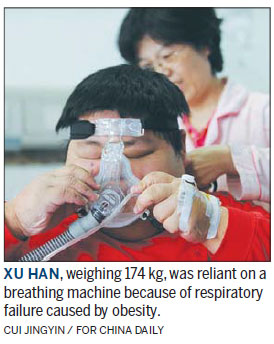Obesity time bomb keeps ticking
Updated: 2016-05-20 08:20
By Wang Xiaodong(China Daily Europe)
|
|||||||||
A growing problem
In 1975, 700,000 Chinese men were obese, which meant the country was ranked 13th in the world. In addition, there were 1.7 million obese women, making China the global No 10. The combined figure accounted for less than 2.5 percent of global obesity.
That picture has changed dramatically. In 2014, China overtook the United States to become the world's fattest nation for both men and women in terms of total numbers. The country was home to 43.2 million obese men (16.3 percent of the global total) and 46.4 million obese women (12.4 percent), according to research published in April by medical journal The Lancet.
The research, based on surveys of more than 19 million people in 186 countries, also showed China was moving higher in the global ranks of "serious" obesity.
In 1975, China's men occupied 60th place, while the women were in 41st place, but by 2014, both men and women were second in the global rankings.
In the past decade, the number of overweight or obese people in China has risen faster than in a large number of developed countries, according to the National Health and Family Planning Commission.
In 2012, nearly 12 percent of Chinese adults were obese, compared with 7.1 percent in 2002. Meanwhile, the figure for children and adolescents - ages 6 to 17 - was 6.4 percent, compared with 2.1 percent in 2002, The Lancet research says.
Yang Qinbing, director of nutrition at Beijing Tsinghua Changgung Hospital and a member of the Chinese Medical Doctors Association, believes China is facing an obesity time bomb.
"The prevalence of obesity has become a serious health problem, and it is one of the most dangerous health risks for the country in the near future," he says.
A rising rate of obesity is closely related to the surge in the incidence of many noninfectious diseases, which are now the primary health threat for China.
According to a report by the World Health Organization last month, the number of Chinese people with diabetes is estimated to be 110 million, about 10 percent of the adult population, but in 1980, the figure was less than 5 percent.
Being overweight and a low level of exercise were primary factors in developing the disease in patients with Type 2 diabetes, which accounts for 90 percent of those with the condition, the report says.
Moreover, the rapidly rising obesity rate among children increases the chances of them contracting chronic diseases such as diabetes, adds Yang Wenying, director of the China-Japan Friendship Hospital's Endocrine and Metabolic Diseases Center in Beijing.
"Clinicians have seen a fast rise in the number of children with diabetes. Most of these young patients are obese or overweight."
Those conditions have been major contributors to a rise in cardiovascular disease. About 290 million Chinese have heart disease, and the illness is now the primary cause of death in the country, according to a report last year by the National Center for Cardiovascular Diseases.
The incidence of hypertension among Chinese men aged 60 and older and with a waistline of 90 centimeters or larger was 78 percent, the center says.
Between 1980 and 2013, the number of cardiovascular patients being treated in China's hospitals rose by an average rate of 9.51 percent a year, higher than the number of patients with other chronic illnesses, it adds.
Today's Top News
Wreckage of crashed EgyptAir plane found at sea
Still learning
EgyptAir denies finding wreckage of missing flight
China urges US to halt close surveillance
Debris found in sea in search for missing MS804
LinkedIn matches refugees with jobs
Top legislator foresees bright future for SAR
UN climate talks resume to write 'rule book'
Hot Topics
Lunar probe , China growth forecasts, Emission rules get tougher, China seen through 'colored lens', International board,
Editor's Picks

|

|

|

|

|

|








